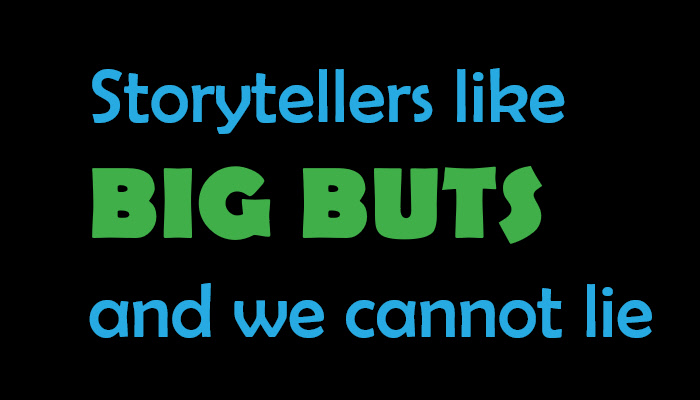
A long time ago, in a marketing department far, far away, I received the worst piece of writing advice ever.
“Replace all of your ‘buts’ with ‘ands’ because they sound nicer.”
For example, if I wrote something like:
“The simulator is fast, but it costs more than the competition,”
I was told to replace ‘but’ with ‘and’ to make:
“The simulator is fast and it costs more than the competition.”
Evidently, conventional marketing wisdom considers ‘and’ as the kinder and gentler conjunction.
ANDS Lead to Inclusion Stories
‘Ands’ probably sound nicer because they lead to inclusion stories which fuse two or more competing ideas together. Since these ideas are dependent upon one another, inclusion-story characters must address them as a single unit.
The best examples of inclusion stories come from improv and The Rule of Agreement. By responding to new story elements with “Yes and,” performers create delightful calamities that flourish with each new line. If the Rule of Agreement is broken with a “Yes but,” however, the resulting buzz-kill saps the story of its energy, limits story options, and ultimately sets the story on a narrowed path.
Inclusion stories are valuable tools for enterprises seeking innovative ideas because of the non-sequitur ideas and situations that they can spawn. They can set the basis for brainstorming or team building activities.
BUTS Lead to Exclusion Stories
Exclusion stories, on the other hand, allow for those same competing ideas to be handled as separate entities. Take the archetypal story of a protagonist who struggles against the efforts of the antagonist. The protagonist can deal with each obstacle that the antagonist presents separately, rather than collectively.
Let’s try an example. What if we compared inclusion and exclusion stories by imagining how the book JAWS would have turned out had Peter Benchley chosen to tell it each way.
The following dialog would initiate the beginning of an inclusion story.
Mayor Vaughn: “Amity needs more tourists at the beach.”
Chief Brody: “Yes, and there’s a big shark in the harbor.”
Since the rules of inclusion preclude the separation of the shark from a safe beach, the characters must seek an inclusive (Yes, and) solution. Perhaps Mayer Vaughn will open a shark-cage store, teach speed-swimming lessons, or develop a shark-repellent sunscreen (SPF 30 = Shark Proof Factor at 30 ft).
Now let’s look at JAWS as an exclusion story.
Mayor Vaughn: “Amity needs more tourists at the beach.”
Chief Brody: “Yes, but there’s a big shark in the harbor.”
The rules of exclusion allow the shark and a safe beach to be addressed separately. Therefore, Benchley seeks to eliminate the shark so that the good people of Amity can return to their carefree, beachgoing ways. Yet, each attempt to deal with the shark creates its own ramifications. First, Benchley chose to have Mayor Vaughn underestimate the risk of opening the beaches, thus leading to new and senseless shark attacks. Next he chose to offer a bounty, which resulted in amateur shark-hunters placing themselves into dangerous situations.
The storyteller plays a god-like role in exclusion stories, meticulously aligning each event and response onto a story path that leads to a final conclusion–just like in the business world.
Which brings us back to:
“The simulator is fast, but it costs more than the competition.”
Cost is a common business complication that sets up its own events and responses. A sales rep wants to discount the product. The finance manager, who’s compensated on corporate margins, doesn’t. Some customers will choose to pay the premium and others won’t. Perhaps those who chose the former accepted creative financing options. Or maybe they figured that since faster simulations shortened product development schedules, that the benefits of a faster time-to-market swamped the additional costs. Either way, exclusion stories have concrete and relatable endings.
Inclusion stories are rosy. Exclusion stories are thorny. And while most marketers lean towards the former, they shouldn’t ignore the latter. Therefore, before blindly replacing all ‘buts’ with ‘ands,’ explore both. At a minimum, you’ll have a better reason for your word choice than “it just sounded nicer.”
Extra Credit: Replace AND THEN with BUT or THEREFORE
In this video, Trey Parker and Matt Stone of the hit series South Park, offer the opposite advice of my old marketing manager. They suggest that whenever you see an “and then,” replace it with a “but” or a “therefore.”